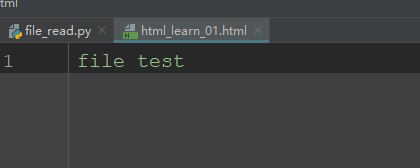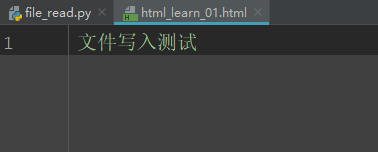python之实现文件的读写
很早之前做自动化测试,并没有将测试数据与数据库关联,而是直接通过json、ymal、excel等文件管理的。那么怎么用python读写文件呢?
在操作文件前,都需要打开文件,打开文件用内置函数open()
open函数
用于打开文件,创建一个file对象,常用格式为:
open(file, mode, encoding)
file:文件路径(可接收相对路径或者绝对路径)
mode:文件的打开模式,可选项,当不填写时默认为r模式
encoding:可选,一般使用utf8
完整格式:
open(file, mode, buffering, encoding, errors,newline, closefd,opener)
buffering:设置缓冲,可选项
errors:报错级别,可选项
newline:区分换行符
closefd:
opener:
mode常用模式:
r: 只读模式,意味着只能读,不能其他操作(追加写入、清空等)
w: 只写模式,文件存在并有内容,则将文件内容全部清空,从0字节开始写,若文件不存在,则先创建文件后,再从0字节开始写
a: 追加模式,将光标置于内容末尾,从末尾开始写入,若文件不存在,则先创建文件后,再从末尾追加写入
b: 读写二进制文件(默认是t,表示文本),需要与上面几种模式搭配使用
实践出真知,打开个文件试试
# 传入绝对路径
f = open(file="D:\demo\htmls\html_learn_01.html")
print(f)
# 传入一个相对路径
t = open("./htmls/html_learn_01.html")
print(t)
"D:\Program Files\Python\Python37-32\python.exe" D:/demo/file_read.py
<_io.TextIOWrapper name='D:\\demo\\htmls\\html_learn_01.html' mode='r' encoding='cp936'>
<_io.TextIOWrapper name='./htmls/html_learn_01.html' mode='r' encoding='cp936'>
可以看到,open()返回了一个文件对象
文件打开了,就要对文件进行一系列操作,常用操作有:
read():读取文件内容,可以指定读取文件内容大小,也可以读取全部内容,当不传或者传入负数,则表示读取文件全部内容。
读取全部(一)
# 传入一个相对路径
t = open("./htmls/html_learn_01.html", encoding="utf-8")
# 读取全部内容
content = t.read()
print(content)
"D:\Program Files\Python\Python37-32\python.exe" D:/demo/file_read.py
<!DOCTYPE html>
<html lang="en">
<head>
<meta charset="UTF-8">
<title>html lean</title>
</head>
<body>
<h1>我是第一个标题</h1>
<p>我的第一个段落</p>
</body>
</html> Process finished with exit code 0
读取全部(二)
# 传入一个相对路径
t = open("./htmls/html_learn_01.html", encoding="utf-8")
# 读取全部内容
content = t.read(-1)
print(content)
"D:\Program Files\Python\Python37-32\python.exe" D:/demo/file_read.py
<!DOCTYPE html>
<html lang="en">
<head>
<meta charset="UTF-8">
<title>html lean</title>
</head>
<body>
<h1>我是第一个标题</h1>
<p>我的第一个段落</p>
</body>
</html> Process finished with exit code 0
读取部分内容
# 传入一个相对路径
t = open("./htmls/html_learn_01.html", encoding="utf-8")
# 读取部分内容
content = t.read(20)
print(content)
"D:\Program Files\Python\Python37-32\python.exe" D:/demo/file_read.py
<!DOCTYPE html>
<htm Process finished with exit code 0
readline():从文件中读取整行内容,若不传或者传入负数,则返回整行内容(包括换行符'\n'),否则返回指定字节大小内容,
读取整行内容(一)
# 传入一个相对路径
t = open("./htmls/html_learn_01.html", encoding="utf-8")
# 读取整行内容
content = t.readline()
print(content)
"D:\Program Files\Python\Python37-32\python.exe" D:/demo/file_read.py
<!DOCTYPE html> Process finished with exit code 0
读取整行内容(二)
# 传入一个相对路径
t = open("./htmls/html_learn_01.html", encoding="utf-8")
# 读取整行内容
content = t.readline(-9)
print(content)
"D:\Program Files\Python\Python37-32\python.exe" D:/demo/file_read.py
<!DOCTYPE html> Process finished with exit code 0
读取一行中部分内容
# 传入一个相对路径
t = open("./htmls/html_learn_01.html", encoding="utf-8")
# 读取一行中部分内容
content = t.readline(5)
print(content)
"D:\Program Files\Python\Python37-32\python.exe" D:/demo/file_read.py
<!DOC Process finished with exit code 0
readlines():从文件中读取文件内容,不传或者传入负数时返回所有行所组成的列表,传入时返回指定字节所在行内所组成的列表
读取全部内容(一)
# 传入一个相对路径
t = open("./htmls/html_learn_01.html", encoding="utf-8")
# 读取整个文件内容
content = t.readlines()
print(content)
"D:\Program Files\Python\Python37-32\python.exe" D:/demo/file_read.py
['<!DOCTYPE html>\n', '<html lang="en">\n', '<head>\n', ' <meta charset="UTF-8">\n', ' <title>html lean</title>\n', '</head>\n', '<body>\n', '<h1>我是第一个标题</h1>\n', '<p>我的第一个段落</p>\n', '</body>\n', '</html>'] Process finished with exit code 0
读取全部内容(二)
# 传入一个相对路径
t = open("./htmls/html_learn_01.html", encoding="utf-8")
# 读取整个文件内容
content = t.readlines(-3)
print(content)
"D:\Program Files\Python\Python37-32\python.exe" D:/demo/file_read.py
['<!DOCTYPE html>\n', '<html lang="en">\n', '<head>\n', ' <meta charset="UTF-8">\n', ' <title>html lean</title>\n', '</head>\n', '<body>\n', '<h1>我是第一个标题</h1>\n', '<p>我的第一个段落</p>\n', '</body>\n', '</html>'] Process finished with exit code 0
读取部分内容
# 传入一个相对路径
t = open("./htmls/html_learn_01.html", encoding="utf-8")
# 读取整个文件内容
content = t.readlines(19)
print(content)
"D:\Program Files\Python\Python37-32\python.exe" D:/demo/file_read.py
['<!DOCTYPE html>\n', '<html lang="en">\n'] Process finished with exit code 0
for line in file: 在读取文件时还可用迭代器获取文件内容
# 传入一个相对路径
t = open("./htmls/html_learn_01.html", encoding="utf-8")
# 逐行打印文件内容
for line in t:
print(line)
"D:\Program Files\Python\Python37-32\python.exe" D:/demo/file_read.py
<!DOCTYPE html> <html lang="en"> <head> <meta charset="UTF-8"> <title>html lean</title> </head> <body> <h1>我是第一个标题</h1> <p>我的第一个段落</p> </body> </html> Process finished with exit code 0
write():将内容写入文件并返回所写内容长度,如果要写入字符串以外的类型数据,需要进行类型转换,否则抛出TypeError: write() argument must be str, not int错误
以只写模式(w)写入已存在的文件中
# 传入一个相对路径
t = open("./htmls/html_learn_01.html", mode="w", encoding="utf-8")
tt = t.write("file test")
print(tt)
"D:\Program Files\Python\Python37-32\python.exe" D:/demo/file_read.py
9 Process finished with exit code 0
写入后文件内容:

以只写模式(w)写入不存在的文件中
# 传入一个相对路径
t = open("./htmls/create.html", mode="w", encoding="utf-8")
tt = t.write("file test")
print(tt)
"D:\Program Files\Python\Python37-32\python.exe" D:/demo/file_read.py
9 Process finished with exit code 0
创建了一个文件并写入内容

以追加写入模式(a)写入已存在的文件中
# 传入一个相对路径
t = open("./htmls/html_learn_01.html", mode="a", encoding="utf-8")
tt = t.write("mode a")
print(tt)
"D:\Program Files\Python\Python37-32\python.exe" D:/demo/file_read.py
6 Process finished with exit code 0
将内容追加写入到文件末尾

以追加写入模式(a)写入不存在的文件中的情况与w模式一样,此处不再举例
writelines():将内容写入文件,接收单个字符串、字符串组成的序列
写入单个字符串
# 传入一个相对路径
t = open("./htmls/html_learn_01.html", mode="w+", encoding="utf-8")
t.writelines("文件写入测试")

写入一个字符串序列
# 传入一个相对路径
t = open("./htmls/html_learn_01.html", mode="w+", encoding="utf-8")
t.writelines(["第一行\n", "第二行\n", "第三行\n"])

写入一个由迭代对象产生的字符串序列
# 传入一个相对路径
t = open("./htmls/html_learn_01.html", mode="w+", encoding="utf-8")
t.writelines([(lambda x: str(x))(x) for x in range(5)])

writable():判断文件是否可写,如果可写返回True,否则返回False
# 文件不可写时返回False
t = open("./htmls/html_learn_01.html", mode="r", encoding="utf-8")
result = t.writable()
print(result)
"D:\Program Files\Python\Python37-32\python.exe" D:/demo/file_read.py
False
# 文件可写时返回True
t = open("./htmls/html_learn_01.html", mode="w", encoding="utf-8")
result = t.writable()
print(result)
"D:\Program Files\Python\Python37-32\python.exe" D:/demo/file_read.py
True
close():关闭已打开的文件(使用open打开文件并操作完后不会自动关闭文件,如果不关闭文件时,进行其他类操作就会报错)
import os
# 不关闭文件时移除文件
t = open("./htmls/html_learn_01.html", mode="w", encoding="utf-8")
t.writelines(["wo\n", "wo\n"])
os.remove("./htmls/html_learn_01.html")
"D:\Program Files\Python\Python37-32\python.exe" D:/demo/file_read.py
Traceback (most recent call last):
File "D:/demo/file_read.py", line 8, in <module>
os.remove("./htmls/html_learn_01.html")
PermissionError: [WinError 32] 另一个程序正在使用此文件,进程无法访问。: './htmls/html_learn_01.html'
import os
# 关闭文件后移除文件
t = open("./htmls/html_learn_01.html", mode="w", encoding="utf-8")
t.writelines(["wo\n", "wo\n"])
t.close()
os.remove("./htmls/html_learn_01.html")
"D:\Program Files\Python\Python37-32\python.exe" D:/demo/file_read.py Process finished with exit code 0
每次打开文件后需要调用close()关闭文件也是挺麻烦的,而且若忘记关闭文件了,会造成意想不到的错误,若想避免,则可引入with
with open() as 文件打开操作完后会自动关闭文件
import os
# 使用with open() as 操作完文件后会自动关闭文件,此时调用os.remove()删除不会报异常
with open("./htmls/html_learn_011.html", mode="w", encoding="utf-8") as f:
f.writelines(["wo\n", "wo\n"])
os.remove("./htmls/html_learn_011.html")
"D:\Program Files\Python\Python37-32\python.exe" D:/demo/file_read.py Process finished with exit code 0
遍历文件后移除文件
import os
# 遍历文件内容,删除文件
with open("./htmls/html_learn_011.html", mode="r", encoding="utf-8") as f:
datas = f.readlines()
for data in datas:
print(data.strip())
os.remove("./htmls/html_learn_011.html")
"D:\Program Files\Python\Python37-32\python.exe" D:/demo/file_read.py
读
写
背 Process finished with exit code 0
文件的基础操作就这样啦,后续会继续补充,下一篇实现文件读取封装
python之实现文件的读写的更多相关文章
- 七. Python基础(7)--文件的读写
七. Python基础(7)--文件的读写 1 ● 文件读取的知识补充 f = open('file', encoding = 'utf-8') content1 = f.read() content ...
- python中 对文件的读写操作 以及如何边写入 边保存flush()
转自:https://blog.csdn.net/t8116189520/article/details/78854708 首先 python中打开文件大致常用的几类如下: 1.写入文件write # ...
- Python基础 | 数据文件的读写
目录 txt txt的读入 txt的写出 csv xls\xlsx 在线网页数据 常用的工具 爬虫的步骤 pdf pdfrw PyPDF2 提取文档信息 word文档 其他统计软件生成文件 本文总结使 ...
- python opencv3 视频文件的读写
git: https://github.com/linyi0604/Computer-Vision # coding:utf8 import cv2 """ 读取视频文件 ...
- Python中对文件的读写
读写文件前,我们先必须了解一下,在磁盘上读写文件的功能都是由操作系统提供的,现代操作系统不允许普通的程序直接操作磁盘. 读写文件就是请求操作系统打开一个文件对象(通常称为文件描述符),然后,通过操作系 ...
- python学习(11)文件的读写操作
1.读文件的7种操作模式 操作模式 具体含义 'r' 读取 (默认) 'w' 写入(会先截断之前的内容) 'x' 写入,如果文件已经存在会产生异常 'a' 追加,将内容写入到已有文件的末尾 'b' 二 ...
- python中的文件的读写
python中的 w+ 的使用方法:不能直接 write() 后,在进行读取,这样试读不到数据的,因为数据对象到达的地方为文件最后,读取是向后读的,因此,会读到空白,应该先把文件对象移到文件首位. f ...
- Python对csv文件的读写操作
python内置了csv模块,用它可以方便的操作csv文件. 1.写文件 (1)写文件的方法一 import csv # open 打开文件有多种模式,下面是常见的4种 # r:读数据,默认模式 # ...
- python pandas 中文件的读写——read_csv()读取文件
read_csv()读取文件1.python读取文件的几种方式read_csv 从文件,url,文件型对象中加载带分隔符的数据.默认分隔符为逗号read_table 从文件,url,文件型对象中加载带 ...
- python对excel文件的读写操作
import xlrd,xlwt data = xlrd.open_workbook('a.xlsx') #读 table = data.sheets()[0] data_list = [] data ...
随机推荐
- 引擎之旅 Chapter.4 日志系统
关于近段时间为何没有更新的解释:Find a new job. 目录 引言 日志语句的分类 控制台窗体 和 VSOutput Tab的日志打印 存储至特定的文件中 展示堆栈信息 引言 一般来说,一个优 ...
- 记一次 .NET 某工控视觉软件 非托管泄漏分析
一:背景 1.讲故事 最近分享了好几篇关于 非托管内存泄漏 的文章,有时候就是这么神奇,来求助的都是这类型的dump,一饮一啄,莫非前定.让我被迫加深对 NT堆, 页堆 的理解,这一篇就给大家再带来一 ...
- 我用canvas带你看一场流星雨
前言 最近总是梦见一些小时候的故事,印象最深刻的就是夏天坐在屋顶上,看着满天的繁星,一颗,两颗,三颗...不由自主地开始了数星星的过程.不经意间,一颗流星划过夜间,虽然只是转瞬即逝,但它似乎比夜空中的 ...
- 应用DriverManager类创建sqlserver数据库连接实例 JSP中使用数据库
JSP中使用数据库 1.JDBC介绍 java数据库连接(java Database Connectivity ,JDBC)是一种用于执行SQL语句的JavaAPI ,由一组使用java编程语言编写的 ...
- TCP 序列号和确认号是如何变化的?
大家好,我是小林. 在网站上回答了很多人的问题,我发现很多人对 TCP 序列号和确认号的变化都是懵懵懂懂的,只知道三次握手和四次挥手过程中,ACK 报文中确认号要 +1,然后数据传输中 TCP 序列号 ...
- 是什么让.NET7的Min和Max方法性能暴增了45倍?
简介 在之前的一篇文章.NET性能系列文章一:.NET7的性能改进中我们聊到Linq中的Min()和Max()方法.NET7比.NET6有高达45倍的性能提升,当时Benchmark代码和结果如下所示 ...
- C#中的特性+反射
反射 反射指程序可以访问.检测和修改它本身状态或行为的一种能力. 程序集包含模块,而模块包含类型,类型又包含成员.反射则提供了封装程序集.模块和类型的对象. 您可以使用反射动态地创建类型的实例,将类型 ...
- Blog1:nchu-software-oop-2022-1~3
(1) 前言 针对在完成三次作业过程中产生的问题进行总结与分析. 三次作业一共十五(9+3+3)道题目,其中前两次难度较为简单,第三次复杂程度飞跃式上涨. 其中,涉及到java语言中基本的输入输出语句 ...
- SoringCloud(四) - 微信获取用户信息
1.项目介绍 2.微信公众平台 和 微信开放文档 2.1 微信公众平台 2.1.1 网址链接 https://mp.weixin.qq.com/debug/cgi-bin/sandboxinfo?ac ...
- Python基础之面向对象:3、继承与派生
面向对象 一.三大特征之继承 python三大特征: 封装.继承.多态 三者中继承最为核心,实际应用对,感受较为直观 封装和多态略微抽象 1.继承的概念 继承的含义: 在现实生活中,继承表示人与人 ...
